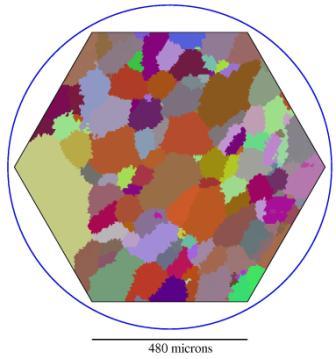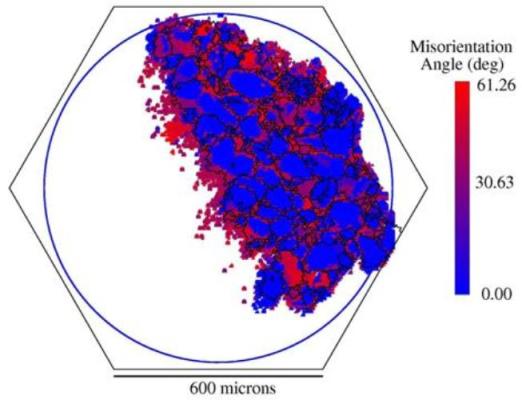Return
to Facilities Home Page
High Energy X-ray Diffraction Microscopy:
Seeing microstructure inside of bulk materials
Internal layer of aluminum polycrystal measured with x-ray
diffraction microscopy at the
Advanced Photon Source (R.M. Suter,
C.M. Hefferan, S.F. Li, D.
Hennessy, C. Xiao, U. Lienert, B. Tieman, refence 1 below):
Colors correspond to different lattice orientations
Circle indicates 1mm nominal sample size
Hexagon indicates simulated region used in reconstruction
|
Table
of Contents (modified July 2008)
- Recent publications
- Examples of reconstructions
- Overview
- Technique summary and schematic
- Apparatus at the APS
- The July 2004 crew
Return to top
Related Publications
- Probing
Microstructure Dynamics With X-ray Diffraction Microscopy,
R.M. Suter, C.M. Hefferan, S.F. Li, D. Hennessy, C. Xiao, U. Lienert,
B. Tieman, J. Eng. Mater. Technol., 130, 021007 (2008); proceedings of
the Materials Processing
Defects-5
conference, Cornell University, July 2007).
-
3-Dimensional
Characterization of Polycrystalline Bulk Materials Using High-Energy
Synchrotron Radiation, U.
Lienert, J. Almer, B. Jakobsen, W. Pantleon, H.F. Poulsen, D. Hennessy,
C. Xiao, and R.M. Suter, Materials Science Forum 539-543, 2353-2358 (2007).
- Forward
Modeling Method for Microstructure Reconstruction Using X-ray
Diffraction
Microscopy: Single Crystal Verification, R.M. Suter, D.
Hennessy, C. Xiao, U. Lienert. Reviews
of Scientific
Instruments, 77, 123905
(2006).
-
Tracking: a
method for structural characterization of grains in powders or
polycrystals, E.M. Laurdisen, S. Schmidt, R.M. Suter, and H.F.
Poulsen, J. Appl. Cryst., 34, 744-750 (2001).
-
Three-dimensional
maps of grain boundaries and the stess state of individual grains in
polycrystals and powders, H.F. Poulsen, S.F. Nielsen, E.M.
Laurdisen, S. Schmidt, R.M. Suter, U. Lienert, L. Margulies, T.
Lorentzen, and D. Juul Jensen, J. Appl. Cryst., 34,
751-756 (2001).
- Future Trends:
Texture Analysis for Structure-Sensitive Properties, B.L. Adams, D. Juul
Jensen, H.F. Poulsen, and R. Suter, Materials Science Forum, 273-275, 29-40 (1998).
Return to top
Some examples of microstructure
measurements using x-ray diffraction microscopy
All data shown here
were collected at the Advanced Photon Source, beamline 1-ID at Argonne
National Laboratory. Participants include Chris Hefferan, Frankie Li,
Robert Suter (CMU) and Ulrich Lienert (APS). Important computational
assistance was provided by Brian Tieman of the APS; analysis was
performed using custom software developed at CMU running on a 68 node
cluster at the APS.
This work was supported
primarily by the MRSEC program of the National Science Foundation under
Award Number DMR-0520425. Use of the Advanced Photon Source was
supported by the U. S. Department of Energy, Office of Science, Office
of Basic Energy Sciences, under Contract No. DE-AC02-06CH11357.
With questions or
comments, e-mail R.M. Suter at suter@andrew.cmu.edu
1. A section through the middle of a NIST certified 152
micron diameter single crystal ruby sphere. a) The color map on
the left shows misorientations from the average orientation.
Red-green-blue color contributions are proportional to the Rodrigues
vector describing the misorientation.
The maximum rotation angle is 0.3 degrees.
The green circle shows the nominal 152 micron sample cross-section
while the hexagon shows the entire region included in the analysis. The
maximum radial deviations are roughly 8 microns. b) The map on the
right shows the 'confidence' fitting paramter indicating maximal
overlap of the simulation with the experimental data in the central
region and reduced overlap near the edges. This reduction is due to
background subtraction removing weak edges of the imaged diffraction
spots. This fit is based on simulation of 1118 ruby Bragg peaks about
115 of which could be observed at more than one detector distance in
the experimental data set. A confidence of 0.79 means that over 90
simulated peaks overlap experimentally observed peaks; 0.33 confidence
implies 38 overlaps.
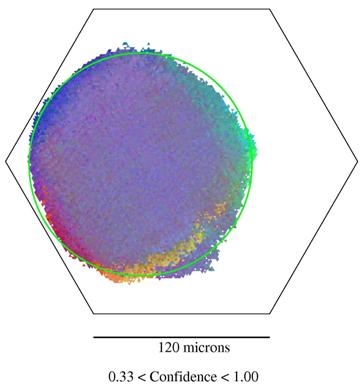
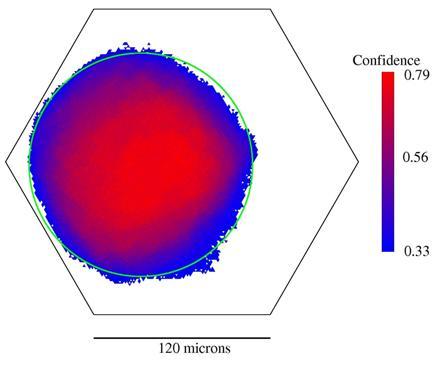
2. Near surface sections through an aluminum 1050 alloy
polycrystal sample. Colors indicate grain orientations,
again coded by Rodrigues vector components. The blue circle indicates
the 1 mm nominal sample diameter while the hexagon is the analysis box.
Black lines in the maps are draw between elements with more than 5
degree misorientation.
- Evidently, the sample surface is not parallel to the x-ray beam
nor is it planar -- in the image at right, 10 microns deeper into the
material, the fitted region has expanded on both the lower left and
upper right sides.
- The appearance of regions of apparently uniform color is the
result of many triangular area elements being independently found to
have similar crystallographic orientation. That is to say, the grain
structure emerges from the analysis -- sharp Bragg scattering is assume
to emerge from each element, but no neighbor correlations are assumed.
On expanded color scales or through quantitative analysis, one sees
that some grains contain orientation gradients corresponding to defect
content. Note that some five degree boundary lines separate regions of
almost the same color -- these are low angle grain boundaries.
- The third image below shows a map of the misorientation between
the two layer shown here. With 10 micron separation between layers,
most of the area is occupied by the same grains and has low
misorientation (blue). Since the grain boundaries are in general tilted
relative to the translation axis, there is significant misorientation
near the grain boundaries (boundaries from the z=0 layer are
superimposed).
- After measuring many such layers, a three dimensional digital
representation of the sample microstructure can be created. Since the
measurement is non-destructive, one can treat the sample in some way
(annealing, straining,...) and re-measure to see how the structure
responds.
z =
0
z = -10um
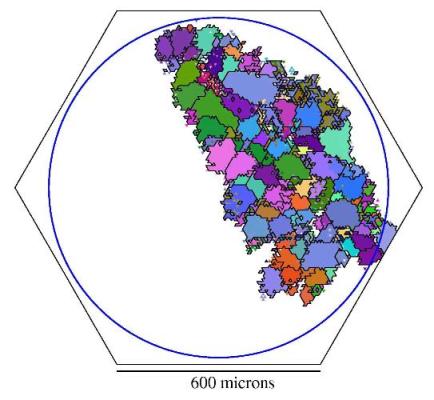
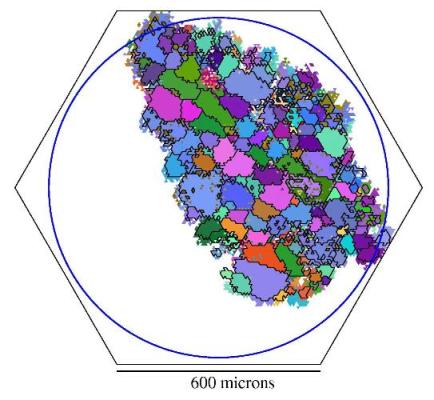
Return to
top
Overview
Polycrystals are aggregates of single
crystals joined together by a network of internal interfaces called
grain boundaries. Polycrystalline materials, in both single and
multi-phase forms, are ubiquitous in engineered systems: integrated
circuits, aircraft and automotive components, communications devices,
machine tools, and many others. The three dimensional geometry,
arrangement, and relative orientation of the grains and the consequent
grain boundary network (i.e., the microstructure) are crucial
determinants of mechanical, chemical, thermal, and electrical
properties. While there has been dramatic progress made in gaining
three dimensional information about microstructure from two dimensional
measurements made at surfaces, (CMU
MRSEC) it remains a great challenge to be able to watch
microstructural evolution in response to external stimuli. With such
observations made deep inside bulk materials, we should be able to
deepen our understanding of phenomena and develop accurate constitutive
relations governing the evolution and thereby learn how to tailor
microstructures to specific applications.
Three Dimensional X-ray Diffraction
Microscopy (see articles listed
above and the monograph by H.F. Poulsen, "Three Dimensional X-ray
Diffraction Microscopy," Springer, 2004) is the only method on the
horizon that can non-destructively image macroscopic volumes of
internal microstructures. Based simply on Bragg diffraction, it is as
versatile as, for example, electron backscatter diffraction analysis of
surface microstructures. But by using high energy x-rays, it looks
through millimeters of m material. Similar to serial sectioning work,
measurements are done layer-by-layer. However, after
the measurement, the sample still exists and can be re-measured after
processing. Real-time dynamics can be monitored. The x-rays can
penetrate sample chambers, making in-situ measurements possible. In
sum, three dimensional x-ray diffraction microscopy promises to open up
the world of microstructure dynamics and response to a new light. In
combination with powerful new computational tools, one can look forward
to a new level of understanding and a new level of "dynamic three
dimensional command over materials structure," (ONR BAA 04-024)
processing, and properties.
As a part of CMU's Mesoscale Interface Mapping
Project
(MIMP) (sponsored by the NSF
MRSEC program) we are working to develop a facility for x-ray
diffraction microscopy at the Advanced
Photon Source at Argonne National
Laboratory. We are specifically working to advance the state of
non-destructive 3D microstructure mapping using high energy x-rays.
Return
to top
Schematic and Outline of the Technique
- White (multi-wavelength) synchrotron radiation from an undulator
source enters the experimental enclosure.
- Bragg diffraction from a bent single crystal of silicon (in
transmission) is used to generate a convergent monochromatic beam (50
-100keV) of x-rays.
- The line focused high energy beam (red) illuminates a ~1 micron
thick section of the sample (green).
- Bragg spots (black) from individual grains are imaged on a CCD
detector (gray); spots have the shape of the illuminated grain cross
section projected onto the detector plane at the scattering angle.
- Measuring a set of spots at multiple sample-to-detector distances
yields the path of the diffracted beam and, by inversion, the position
of
the diffracting grain.
- Step-wise measurements over a range of sample orientations, omega, yield multiple spots from
each grain; this implies complete crystallographic orientation
information and projected images of each grain from multiple points of
view.

- After image processing, our analysis code performs a simulation
of the entire measurement and microstructure. The sample space is
gridded and the crystallographic (or chemical) phase and orientation at
each grid element is adjusted to optimize the overlap
of simulated Bragg scattering with the experimental data.
Return
to top
Apparatus at APS beamline XOR-1
The following images were taken during our
January 2008 beam time:
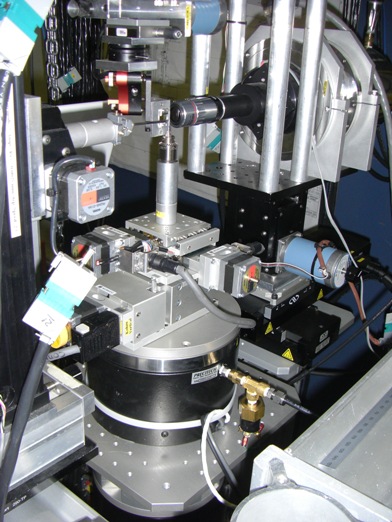 |
Sample
stage at 1-IDB.
- CCD camera lens collects scintillation light off a 45
degree mirror.
- Ce/YAG scintillator and 45 degree mirror holder
- Beam block (black)
- Sample (vertical cylinder)
- XYZ translations stage
- Precitech air-bearing rotation stage
|
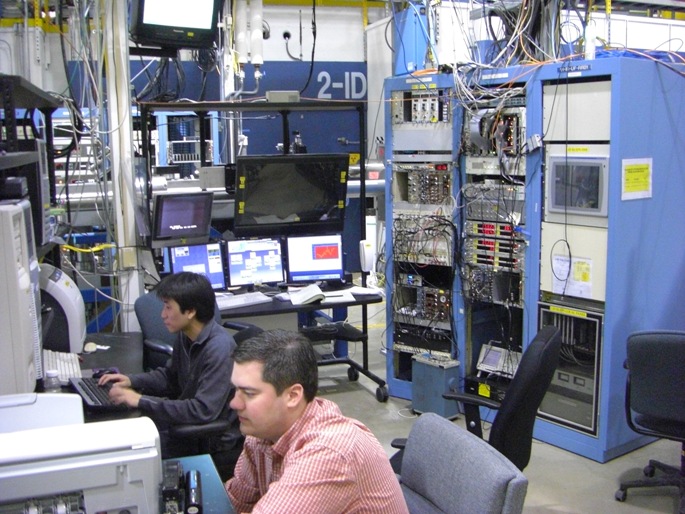 Frankie and
Chris at the controls
Frankie and
Chris at the controls
Return to top
